Do you like to see your reef aquarium fabulously? The best answer is a bare bottom reef tank setup. This has the power to make your job easy. Because if you go bare bottom, you can gather many advantages. Surely, this article will cause you to wonder. So, the choice is yours.
What Is a Bare Bottom Reef Tank?
Jump To
- 1 What Is a Bare Bottom Reef Tank?
- 2 Bare Bottom Reef Tank Maintenance
- 3 Advantage of the bare bottom reef tank
- 4 How To Keep Coral Species In The Bare Bottom Reef Tank
- 5 Coral Species For Bare Bottom Reef Tank
- 6 Fish Species For Bare Bottom Reef Tank
- 7 Non-Fish Species For Bare Bottom Reef Tank
- 8 Can Plant Grow In Bare Bottom Reef Tank
- 9 Plants For This
- 10 Better Bare Bottom Tank Vs Sand Bottom Tank
The bare bottom reef tank is the marine aquatic setup without any form of the substrate at the bottom of the tank. Through this setting, you can create a pristine appearance for your reef aquarium by emphasizing your aquarium rocks and marine life.
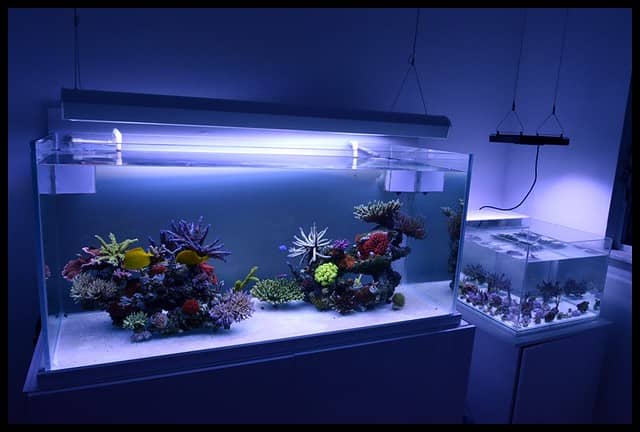
Bare Bottom Reef Tank Maintenance
Tools Needed
You need very few tools to maintain your bare bottom reef tank.
- You need a magnet cleaner to clean fish poops under the rocks. Ex: bare bottom cleaner made by LPL
- You should need the best vacuum cleaner to clean your bare bottom reef tank
Filter
You can install a biofilter to your bare bottom reef tank.
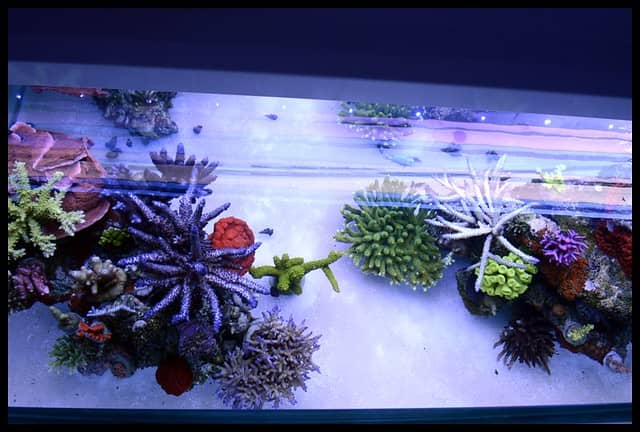
Advantage of the bare bottom reef tank
Easy To Maintain.
The bare bottom reef tank is easy to clean and siphon. Because the lack of sand prevents fish waste and other contaminants from depositing in the sand or gravel. Further, Because of the lack of sand in your aquarium, you can easily clean the tank. Especially around the rocks. The reason is, that fish waste, uneaten food and other contaminants do not accumulate in tank substrates. Also, you can easily scrub your tank glasses.
Do Not Need To Worry About The Cleaning Crew.
Due to the bottom substrates, much waste and algae are deposited in your tank. Because of that many aquarium holders try to keep cleaning crew in their tanks like stomatella snails. Here, you do not need to worry much about this, because of the lack of sand and gravel.
Waste Control
Substrates do not support filtering the waste materials from the tank. They trap waste. Because of that, tank wastes do not filter out and it starts to decompose in the tank. The fish waste deterioration process generates ammonia, nitrates, nitrites and phosphate. If you maintain a reef aquarium, you should try to control these by-products at zero levels.
Because ammonia, nitrates, and nitrites can badly affect your coral and marine creatures. Also, phosphates and nitrates can slow and prevent the growth of corals. Moreover, it will de-color corals. You can reduce these impacts in bare bottom reef aquariums. Because there is no chance to remains any debris in the tank and filter out all waste compounds from the water.
No Sandstorms
In a bare bottom reef aquarium, you can place the power heads and blowers anywhere. Because you do not worry about the blowing sands, gravel, and detritus around the water. Simply, this bare bottom setup allows you to maintain clear water in your reef tank with little effort. Also, in this setup, you can increase the water flow without any sandstorms blowing around the aquarium. If you like to rear small polyp stony (SPS) in your reef aquarium, this is good news for you. Because SPS prefers to live where it has a high flow rate. In addition to that, some coral also likes high flow rates.
Visible Dead Zone
Bare bottom fish tanks allow you to identify the exact places where fish waste and other contaminants build up. This aquarium setup lets you see dead zones too.
No Unwanted Bacteria Or Parasites
The bare bottom reef aquarium setup does not allow the growth of unnecessary guests in the tank-like flatworms, bristle worms, and cyanobacteria. These critters tend to reproduce in the sand and gravel substrates. Also, these animals are a hassle to remove. But if you have a bare bottom reef aquarium, you do not worry about this.
Lower The Cost.
You do not require sand or gravel substrate in your bare-bottom aquarium. Therefore, you can save money. Because you do not have to spend money on expensive sands and gravels. Further, it also reduces the cleaner organisms’ costs, water maintenance costs, and disease prevention costs.
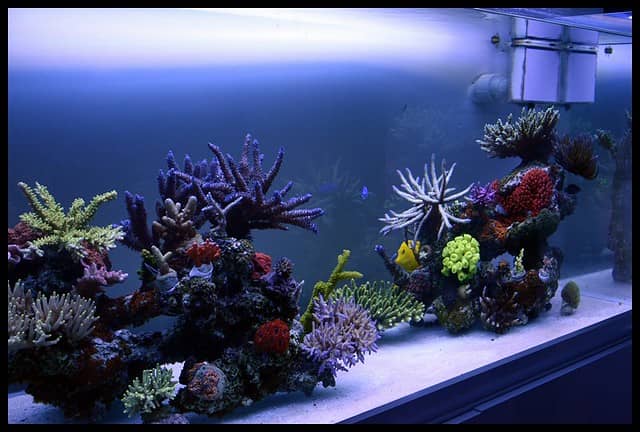
How To Keep Coral Species In The Bare Bottom Reef Tank
It is not more different than setting up other reef tanks. Here you should follow the acclimating process before adding reef and fish to the tank. It helps corals and other saltwater creatures to adjust to the environment.
- Very first, you should clean your tank
- Then fill the tank with prepared saltwater.
- Clean your live rocks properly and place them in your tank in the proper way
- Then place your aquarium equipment
- Let your tank run for 3-4 weeks
- During this period, you should perform weekly water changes of 50%.
- Also, during this period, leave the lights off. It helps to grow algae.
- After 3-4 weeks, you should check the water condition by using an aquarium water test kit. If your water is in the right condition (ammonia and nitrite levels are zero), you can introduce the first inhabitant to your tank. You can choose a snail or crab.
- Here you should follow a 12 hours cycle for your lighting in the tank (lights on for 12 hrs during the daytime and lights off for 12 hrs at night).
- Then after two weeks, you should make a 25% water change and introduce the first coral.
- Here you should choose a basic coral-like polyp. Then you can gradually introduce other corals and give them two weeks to acclimate to your tank before you add fish and invertebrates.
- After introducing all inhabitants to the tank, you should perform 25% water changes at least once per month.
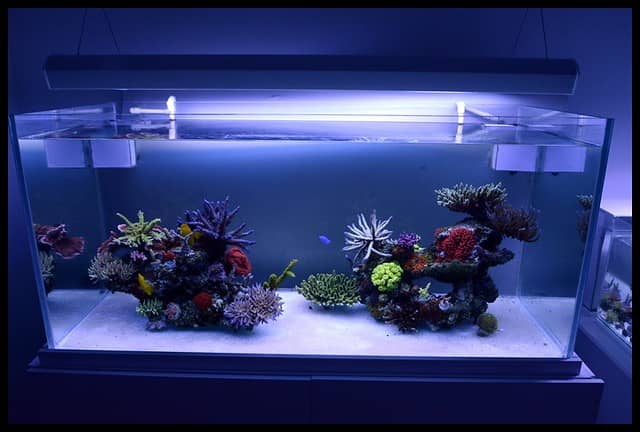
Coral Species For Bare Bottom Reef Tank
Montiporas
Montipora is the second most abundant coral species after Acropora. Members that belong to the genus Montipora exhibit different growth morphologies including laminar, submassive, foliaceous, branching, and encrusting. Montipora corals have a variety of colors. Orange, pink, green, brown, purple, yellow, blue, tan, and grey are some of these colors. Some members of the genus Montipora namely, Montipora spumosa and Montipora verrucosa show a mottled appearance.
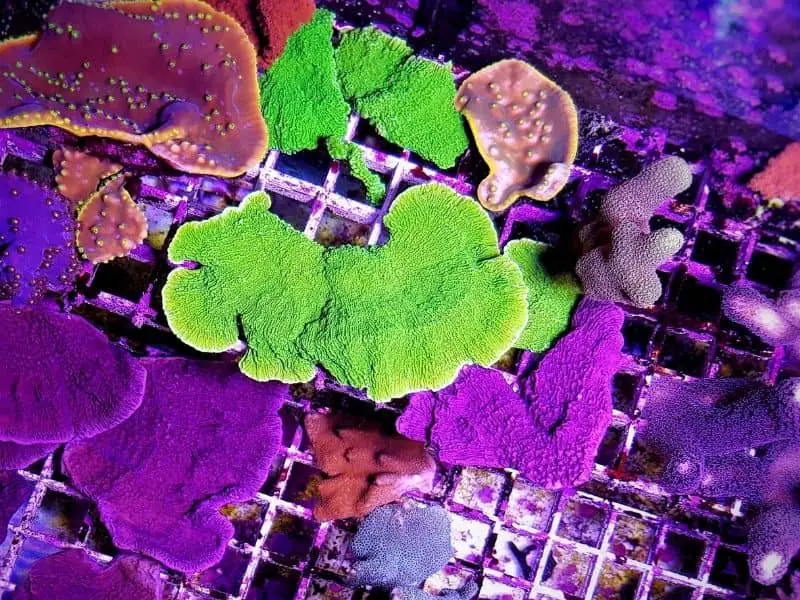
Favia
Favia belongs to the genus of reef-building stony corals and it is a member of the family Mussidae. Common names are Brain coral, Pineapple Coral, Moon Coral, and Closed brain coral. The members of this genus are massive or thickly colonial corals. Some are dome-shaped and some are flat in shape. Further among them, few are foliaceous. You can find them in the Atlantic Ocean and indoor pacific. They are available in red, green/blue colors. This coral type is easy to rear and recommend for beginners.
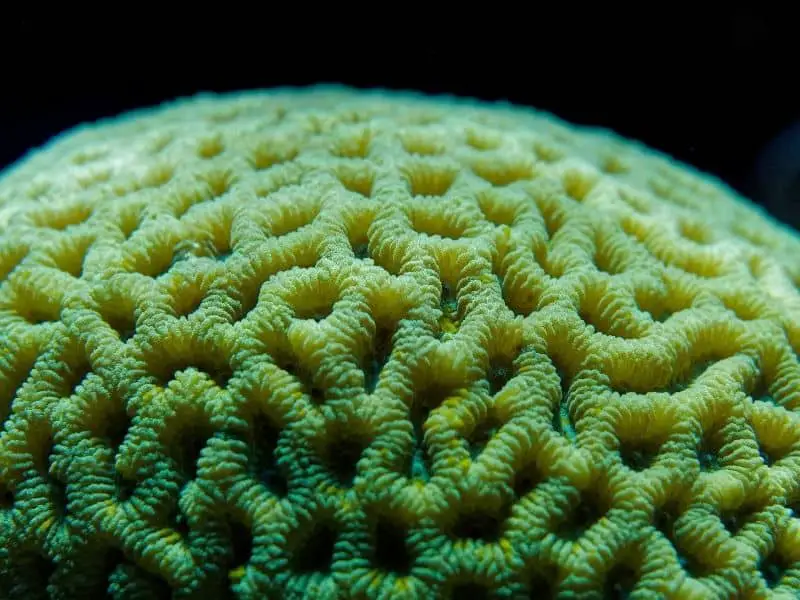
Favia Water Quality Requirements
| Alkalinity | 8-12 dKH |
| Ammonia | Zero |
| Nitrates | Zero |
| Nitrites | Zero |
| Phosphates | Zero |
| Calcium | 400+ parts per million |
| pH | 8.1-8.4 |
| Salinity – Specific gravity | 1.023- 1.025 |
| Temperature | 73-84 Fahrenheits (22.8-28.8 Celsius) |
Porites
Porites are SPS corals (small polyp stony). They look like fingers. They belong to the Poritidae family. You can find them in the tropical Western Pacific Ocean and Indo-West Pacific Ocean.

Porites Water Quality Requirements
| Alkalinity | 3.5 meq/1 |
| Ammonia | Zero |
| Nitrates | Zero |
| Nitrites | Zero |
| Phosphates | Zero |
| Calcium | 380 to 430 ppm |
| pH | 8.1-8.2 |
| Salinity – Specific gravity | 1.023-1.025 |
| Temperature | 74-83 Fahrenheits (23-28 Celsius) |
Green Star Polyps
Green star polyp is commonly known as star polyp, daisy polyp, and starburst polyp. This coral type is hardy. Because you can keep them easy. They are fast-growing. This polyp has green polyps, a white center, and a purple mat or stolon.
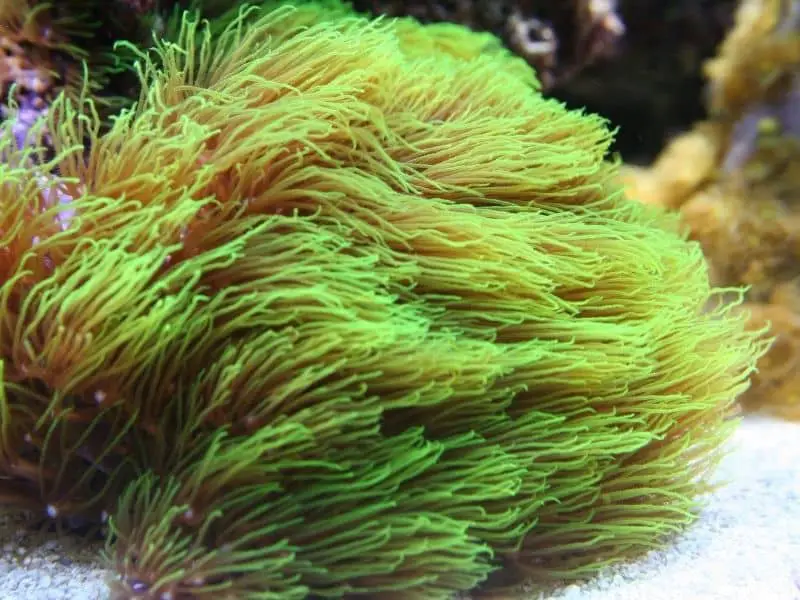
Green Star Polyps Water Quality
| Alkalinity | 8-12 |
| Ammonia | Zero |
| Nitrates | Zero |
| Nitrites | Zero |
| Phosphates | Zero |
| Calcium | 400 ppm |
| pH | 8.2 |
| Specific gravity | 1.023-1.025 |
| Temperature | 78-82 Fahrenheits (25.5-27.8Celsius) |
Mushrooms corallimorphs
Their common names are false corals, coral anemones, Disc anemones, Mushroom corals, and mushrooms. This coral type is also a good choice for your bare bottom reef tanks. They have a range of stunning colors such as green, purple, red, grey, and blue. This type is not only attractive but also hardy. Therefore, it can be recommended for beginners.
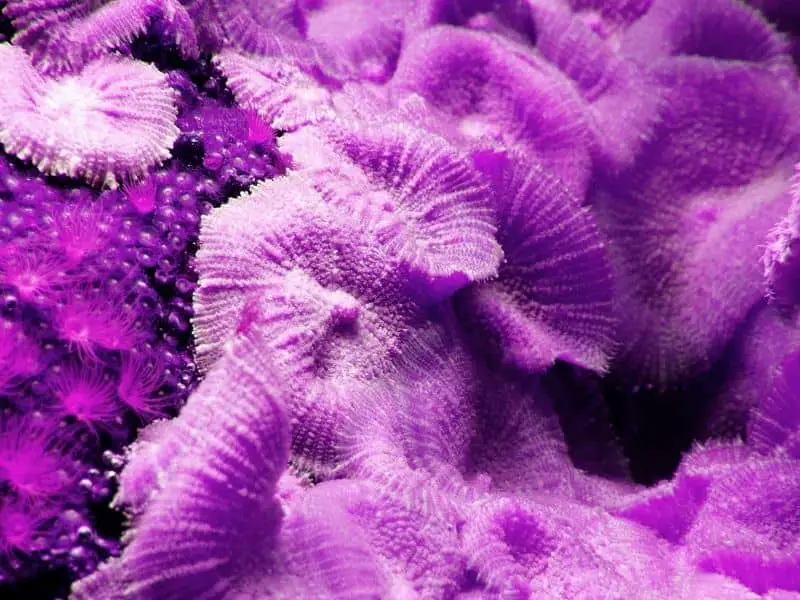
Leptoseris
Leptoseris coral is known as wrinkle coral. They are small polyp stony corals. They are also easy to care for. Leptoseris are in yellow, orange and red.
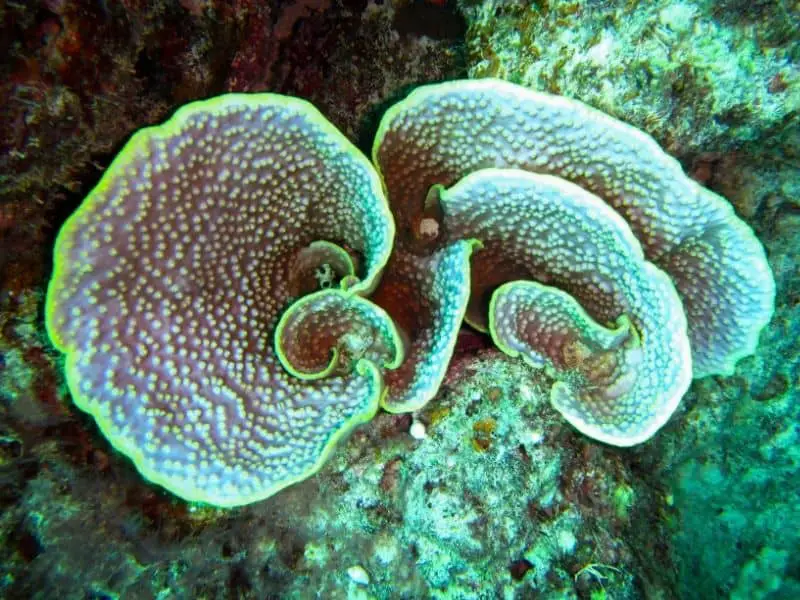
Leptoseris Water Quality Requirements
| Alkalinity | 8-9.5 dkh |
| Ammonia | Zero |
| Nitrates | Zero |
| Nitrites | Zero |
| Phosphates | Zero |
| Calcium | 420-440 ppm |
| pH | 8.1-8.4 |
| Specific gravity | 1.023-1.025 |
| Temperature | 78-82 Fahrenheits (25.5-27.8Celsius) |
Fish Species For Bare Bottom Reef Tank
Here, you should consider the corals in your tank. Because some corals do not accept some fish species. Generally, you can keep these fish species in your reef aquarium. But you should highly consider the coral types in your tank when you select the fish species.
Reef-safe fish species.
- Japanese swallowtail angelfish
- Coral beauty angelfish
- Fisher’s angelfish
- Flame angelfish
- Lemon peel angelfish
- Masked angelfish
- Multicolor angelfish
- Flesh percula clownfish
- True percula clownfish
- Tomato clownfish
- Clarkii clownfish
- Fire, red and black or cinnamon clownfish
- Pink skunk clownfish
- Saddleback clownfish
- Green mandarin fish
- Psychedelic mandarin fish
- Small gobies
- bass lets
- Firefish
- Blennies
- Cardinalfish
- Starfish
- Larger damselfish.
Here you should consider water conditions and other requirements that fish need to live. Further, you should have proper knowledge about the fish species before you add them to your reef tank. Because there are so many important factors to fulfill when you rear the fish.
Non-Fish Species For Bare Bottom Reef Tank
Here also you should consider the coral types that you wish to grow in your reef aquarium before selecting the non-fish species. There are some reef-safe non-fish species. These are;
- Turban snails
- Cerith snails
- Donkey’s ear abalone
- Fighting conch snail
- Gold ring money cowrie
- Banded trochus snail
- Stomatella snail
- Nerite snail
- Turbo snail
- Nassarius snails
- Harlequin shrimp
- Cleaner shrimp
- Sexy shrimp
- Boxer shrimp
- Scarlet skunk cleaner shrimp
- Peppermint shrimp
- Marbled shrimp
Here you should consider water conditions and other requirements that non-fish species require to live. Further, you should have proper knowledge about the non-fish species before you add them to your reef tank. Because there are many important factors to fulfill when you rear the non-fish species. You should avoid flowing non-fish species in your reef aquarium. Because they are not safe for the reef. Flamingo tongue.
- Pyramid snail
- Vermetid snail
- Keyhole limpet
Can Plant Grow In Bare Bottom Reef Tank
Yes, you can grow the plant in your bare bottom reef tank. There are aquatic plants that do not need sand substrate to survive in an aquarium. Hence, you can plant saltwater aquarium plants that can grow without sand substrate in your bare bottom reef aquarium.
Plants For This
Dragon’s Tongue Macroalgae (Halymenia dilatata)
Dragon’s Tongue Macroalgae is the most popular aquarium plant for reef aquariums. They are suitable for your bare bottom reef aquarium. Because they grow without sand substrate. Dragon’s Tongue Macroalgae can grow free-floating or attach to the rock. In their natural habitats, these plants are normally associated with reefs. This saltwater plant can grow up to 1.5 inches in height. And it has the ability to add a stunning and attractive look to your bare bottom reef aquarium. Because they are pink to deep red in color. You should maintain the following water parameters that allow them to grow happily.
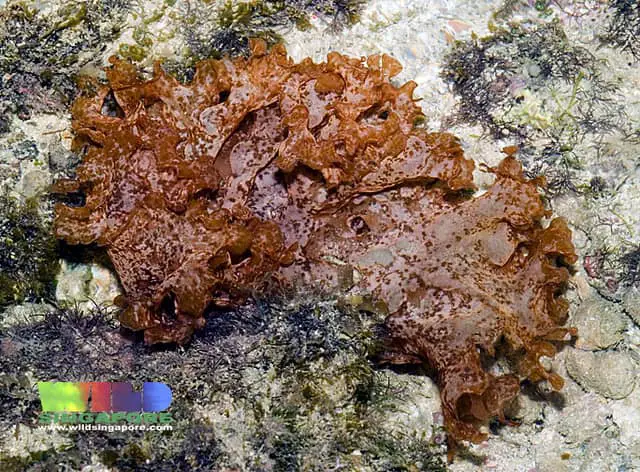
Dragon’s Tongue Water Quality Requirements
| Temperature | 78-83 Fahrenheit |
| Water hardness | 8-12 dKH |
| Salinity level | 1.023-1.025 Specific gravity |
| pH level | 7.8-8.4 |
The Green Finger Algae
They have small fingers that poke up in their central area. That’s why they got this name. The green finger algae do not need sand substrate. They can live on rock or other hard spaces. The special thing is this plant provides natural filtration and oxygenation. It will help to keep your bare bottom aquarium looking fresh and beautiful. If you provide the following conditions properly, this plant will grow fast.
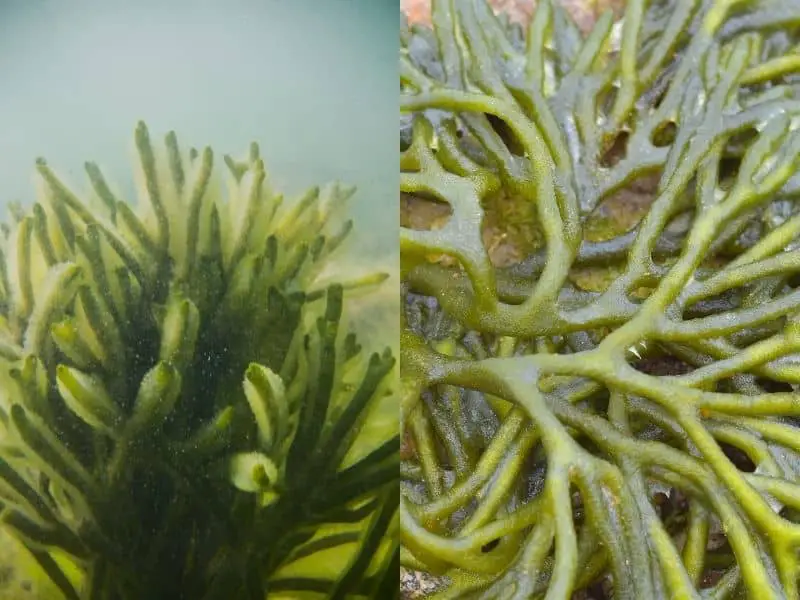
The Green Finger Algae Water Quality Requirements
| Temperature | 72-78 Fahrenheit |
| Water hardness | 8-12 dKH |
| Salinity level | 1.023-1.024 Specific gravity |
| pH level | 8.1-8.4 |
Tufted Joint Algae (Cymopolia Barbata)
Tufted Joint Algae is a wonderful display algae. This is like a beautiful small tree. In this plant, each trunk is made of a segment. At the end of these trunks, there are small hairs. This plant can rear in bare bottom reef aquariums. Usually, they mount on live rocks.
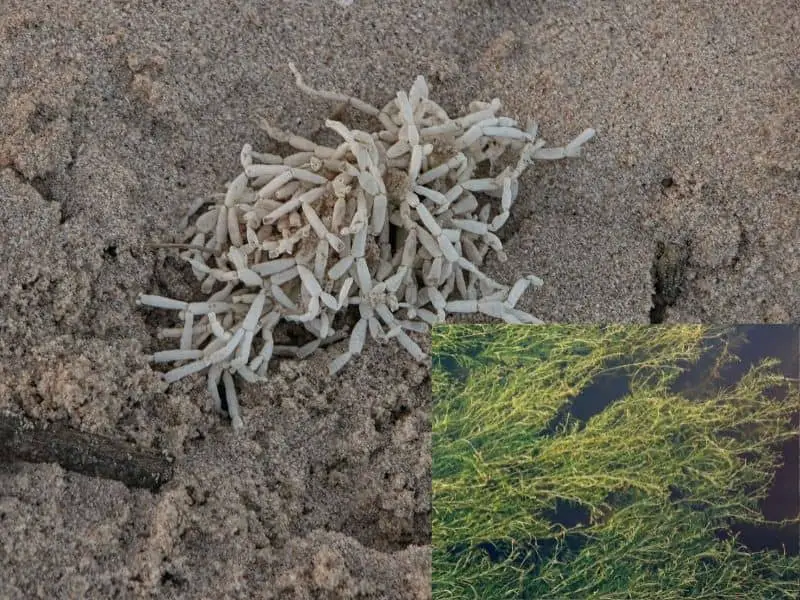
Tufted Joint Algae Water Quality Requirements
| Temperature | 72-86 Fahrenheit |
| Water hardness | 8-11 dKH |
| Salinity level | 1.024-1.026 Specific gravity |
| pH level | 8.1-8.3 |
Spaghetti Algae
Spaghetti algae are one of the water quality control plants in marine aquariums. If you introduce Spaghetti algae to your marine tank, they help you to reduce nitrates by absorbing nitrates. It also releases oxygen into the tank. As a result of this, they support the balance of the ammonia cycle in your marine aquarium. In addition to that, they cause a buffer pH level in your tank. The special fact is, Spaghetti algae like to grow freely and float in your tank.
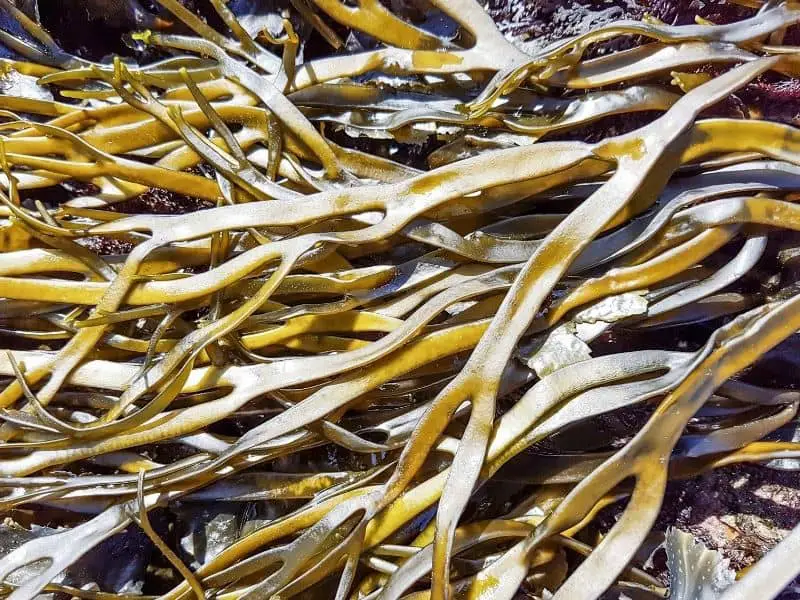
Spaghetti Algae Water Quality Requirements
| Temperature | 78 Fahrenheit |
| Water hardness | 8-12 dKH |
| Salinity level | 1.023-1.025 Specific gravity |
| pH level | 7.8-8.4 |
Mermaid’s Fan Plant
Mermaid’s Fan Plant is the most popular plant in marine tanks. It has a unique shape because they grow as a single broad leaf. They are bright green in color. The happy news is, that Mermaid’s Fan Plant also can be kept in your bare bottom reef tank. Because they can grow on live rocks. Also, they are reef-safe.
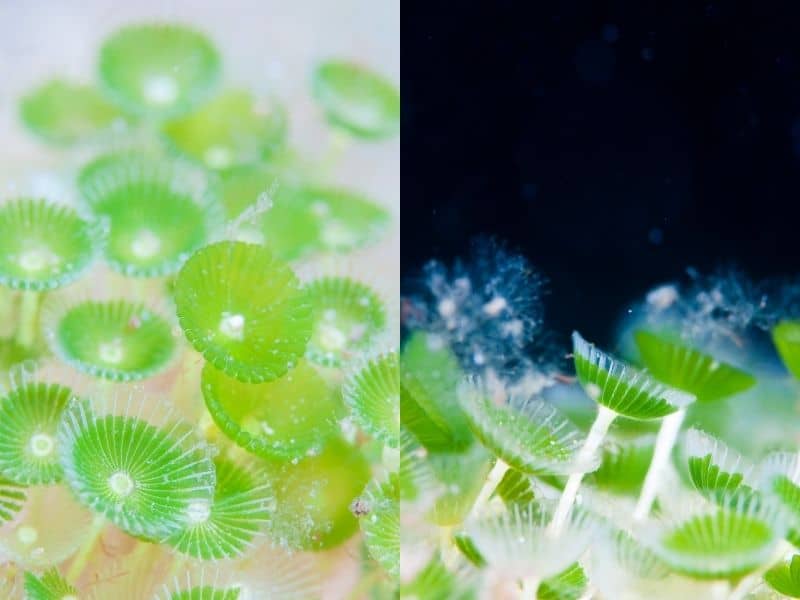
Mermaid’s Fan Plant Water Quality Requirements
| Temperature | 72-78 Fahrenheit |
| Water hardness | 8-12 dKH |
| Salinity level | 1.023-1.025 Specific gravity |
| pH level | 8.1-8.4 |
In addition to these plants, you also can choose other saltwater plants for your bare bottom reef tank. But you should consider a few factors.
1. The particular plant should be reef safe
2. The particular plant can grow without sand substrate
3. The particular plant should not badly affect the lives in your aquarium including fish species, non-fish species, and live plants.
Related How Long Can Aquarium Plants Survive In The Mail?
Better Bare Bottom Tank Vs Sand Bottom Tank
Bare Bottom Tanks Pros vs Cons
| PROS | CONS |
|---|---|
| The bare bottom reef tank is easy to clean and siphon. Because the lack of sand prevents fish waste and other contaminants from accumulating. | No substrate. It reduces natural experience. |
| No need much worry about the cleaning crew | Few beneficial bacteria are available |
| The bare bottom helps to control the waste. The substrate does not support the filter of the waste in the tank, and they trap the waste. Hence, accumulated waste deteriorates in the tank. | If you create rock structures, there is a risk. Because rock can easily fall or slide on bare bottoms. |
| In a bare bottom reef aquarium, you can place the power heads and blowers in any place. Because you do not worry about the blowing sands, gravel, and detritus around the water. | Cannot rear the corals that need to survive sand beds. |
| You can increase the water flow without any sandstorms blowing around the aquarium | Some marine water aquatic plants need sand or gravel substrate to establish |
| In bare bottom fish tanks allow you to identify where fish waste and other contaminants build up. | |
| The bare bottom reef aquarium setup does not allow to grow unnecessary guests in the tank like flatworms, bristle worms and cyanobacteria. | |
| There is no sand or gravel substrate in your bare-bottom aquarium. Because you do not have to spend money on the expensive sands and gravels. | |
| Easy to maintain water quality parameters. Hence fish and coral can live happily | |
| Powerhead and filter system can protect from sand and gravel | |
| Easy to maintain and clean | |
| Can use the same water for 2,3 weeks |
Sand Bed Aquarium Pros vs Cons
| PROS | CONS |
|---|---|
| Sandbeds promote the natural experience and natural view of your reef aquarium. | Substrates limit the water flow. With substrate, you cannot increase the water flow at a high level like bare bottom tanks. |
| Sandbeds increase the amount of surface area to live beneficial bacteria. | The sand bed can store large bioloads in your aquarium. And it causes to increase in the ammonia, nitrite, and nitrates levels in your aquarium. This is harmful to your corals as well as fish species and non-fish species. |
| Also, sand beds provide habitat to some like jawfish, sand sifting gobies, wrasses, and other small burrowing fish. | When you have a sand substrate, it is difficult to clean your tank. |
| Some coral also likes to live in sand beds rather than the bare bottom. Ex: plate corals (diaseris, herpolitha corals) | Sand bottoms allow unnecessary guests to grow in the tank like flatworms, bristle worms, and cyanobacteria. |
| A Sand substrate is better to hide something like equipment. | You have to spend money to purchase high-quality sand. |
| Through sands, you can soften the shape edges in your reef tank | sand Cleaning is a bit difficult |
Read More Live Plants For Saltwater Aquariums | 9 plants to know |
